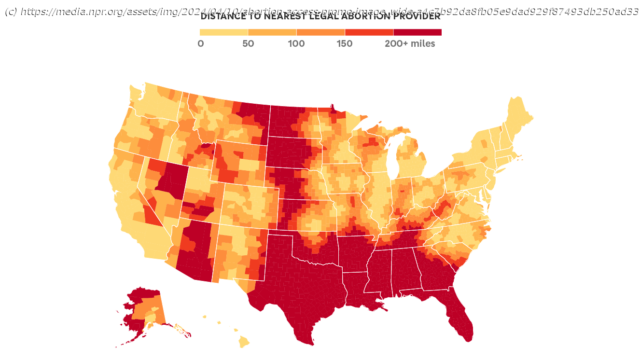How far do women have to travel to access abortion care? An economics professor has been tracking that data since 2009. Interactive maps show how access has changed dramatically since 2021.
In a few weeks, Florida and Arizona are set to join most states in the southern U.S. in banning abortion. It’s a significant shake up to the abortion legal landscape, and data shared exclusively with NPR maps and quantifies what the changes will mean for millions of Americans.
On Tuesday, the Arizona Supreme Court cleared the way for an 1864 law to be enforced. That law completely bans abortion except when someone’s life is in danger. Last week, the Florida Supreme Court made its decision to allow a ban on abortions after six weeks gestation to take effect on May 1.
Caitlin Myers, an economics professor at Middlebury College in Vermont, has been tracking abortion facilities and travel distances since 2009. She analyzed how these latest rulings will affect the access map.
“Because of these bans, it’s about 6 million women of reproductive age who are experiencing an increase in distance of more than 200 miles,” she says.
She points out that Floridians who are seeking abortions after six weeks will have to travel nearly 600 miles to North Carolina, which has a 72-hour waiting period. “So we’re talking about a day’s drive to a state that requires you to engage in this multi-day process,” Myers says. “A lot of people might end up going several hundred miles further to Virginia.”
For people in Arizona, after the 1864 law takes effect, “their nearest destinations are pretty long drives. They’re going to be facing hundreds of miles to reach southern California, New Mexico, Colorado,” Myers says. “I think Arizona spillover is likely to affect California in a way that California hasn’t yet been affected by bans.”
Myers helms the Myers Abortion Facility Database. She has gathered data about facilities – including clinics, doctors, and hospitals that publicly indicated that they provide abortions – going back more than a decade, using data licensure databases, directories, and Wayback Machine captures of websites from years past.
Home
United States
USA — mix How Florida and Arizona Supreme Court rulings change the abortion access map






